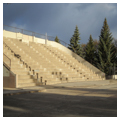Platted c. 1877, Island Park was a gift to the city from the Northern Pacific Railway. It is one of Fargo’s most historically important public open spaces. The site was subject to frequent flooding until the course of the Red River was altered by construction of an earthen levee that is popular for sledding in the winter. Local businesspeople commissioned the construction of a bandstand (2010 restored) that, today, is used more for outdoor weddings than for musical performances. The park includes an array of statues and recreational structures, notably a WPA-funded swimming pool complex and the facade of the Fargo Arena. The arena originally accommodated ice skating and winter sports, but was dismantled and relocated to serve as an aircraft hangar during World War II. Hunter-Grobe worked with Park District representatives to assure that the historic facade was preserved as a front screen for the new swimming pool (1986).
The arena was an innovative longspan, laminated wooden-arch structure by Fargo architect Houkom (1891–1980). In 1973 Houkom was interviewed by architectural historian Ronald Ramsay about his experiences transitioning from architecture school at the University of Michigan to architectural practice in Fargo. Houkom recalled that “essentially everything we had learned about emerging design technology and construction materials was out the window [with the Great Depression]. The new ground rules had everything to do with using low cost materials that afforded the maximum opportunities for unskilled human labor.” In light of those conditions, the hand-formed and hand-rubbed cast-concrete features and wooden arches make sense.
The WPA swimming pool complex consisted of an outdoor pool (now filled in), grandstand seating with locker rooms below, and a Moderne canopied tower that contained an outdoor shower and foot-wash. Space below the grandstand has served recreational needs of several groups over the years. Recently constructed hard-surface game courts (basketball, tennis), though popular, are less sympathetic to the historic character and usage of the park. The piecemeal design of the YMCA from 1965 to 2000, situated at the northeast edge of the park, is also an unfortunate detraction from the historic park features. The park contains two often overlooked works of figurative art: a somewhat generic Civil War memorial (c. 1913) and a more noteworthy sculpture (installed 1908) of Norwegian poet and philosopher Henrik Arnold Wergeland by internationally famous Norwegian sculptor Gustav Vigelund. While Vigelund’s representations of the human figure in Oslo, Norway, are well known, this commissioned statue is the only known sculpture by Vigelund in North America, and one of his few works outside Norway. Dotted with large oaks, elms, and coniferous trees, Island Park is a shady, reposeful amenity at the foot of downtown and a transition to southside residential neighborhoods.












